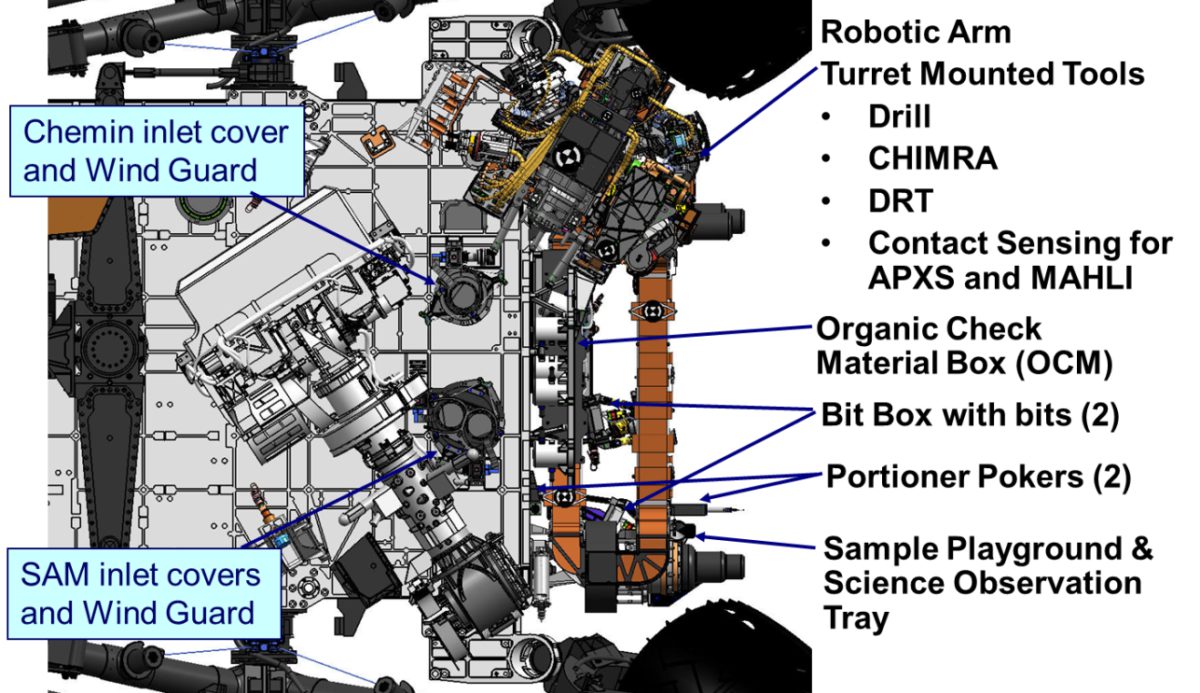Daniel Limonadi • Aug 20, 2012
Sampling Mars, Part 2: Science Instruments SAM and Chemin
In my previous post about the Curiosity rover's Surface Sampling and Science (SSS) system, I provided a quick overview of the design of and rationale for the hardware. In this post, I'll talk about the two science instruments that will analyze samples of powdered rock and soils: Sample Analysis at Mars (SAM) and Chemistry and Mineralogy (CheMin).
Sample Analysis at Mars (SAM)
The SAM instrument suite is a small room-size organic chemistry laboratory stuffed into a box the size of a microwave oven. It weighs about 42 kilograms and makes up about half of the total instrument payload mass of Curiosity. It has three internal instruments to analyze solid and atmospheric samples: a Quadrupole Mass Spectrometer (QMS), a Gas Chromatograph column array with six columns (GC, supplied by the French space agency), and a Tunable Laser Spectrometer (TLS).
The Sample Acquisition, Processing and Handling subsystem (SA-SPaH) prepares very small samples of powdered rock or soil, about the size of half a baby aspirin. It feeds each sample into one of two solid sample inlet funnels. These funnels feed a two-ring carousel that carries 74 sample cups. Once filled with a sample, a cup is placed into one of two pyrolosis ovens that can heat the solid samples to approximately 900 Celsius and 1100 Celsius, respectively.
Heating the samples to such high temperatures drives gases off of the sample. More volatile materials -- such as organics -- are driven off at lower temperatures, but as SAM increases the heat it eventually vaporizes the entire sample, including any minerals present. The heat in the ovens is increased very slowly so that the QMS, GC and TLS can analyze the composition of the gases as they change with the ovens' temperature. The SAM science team works backward from the gas composition to determine what minerals were present that vaporize to those specific gases at those specific temperatures.
SAM also has two direct atmospheric inlets to allow sampling of the atmosphere. Tying all these instruments together is an amazing plumbing system that includes two helium carrier gas tanks and two wide-range pumps to motivate gas through the system.
All of this makes SAM the most capable and most sensitive chemistry and organic detection instrument ever sent to another planet. Some of the most important SAM science will be done by just sniffing the Martian air with its instrument suite. This will allow us to refine our understanding of the amount of methane within the Martian atmosphere. Minute quantities of methane were first detected at Mars by the European Mars Express spacecraft and Earth-based observatories. The amount of methane detected by both methods is only about 10 parts per billion, which is right around the detection limit of the instruments used. SAM, with its TLS, will be sensitive to parts per trillion of methane, better than 3 orders of magnitude improvement.
A typical SAM experiment run will take about 4 to 10 hrs to run depending on the type of sample and the type of analysis being done. Solid sample analysis runs also take several sols (Mars days) of preparation – doing things like pre-conditioning sample cups in the ovens to burn off any collected volatile contamination that might skew the science results.
Chemistry and Mineralogy (CheMin)
The CheMin instrument is the first X-Ray Diffraction (XRD) instrument ever flown into space. The wonderful thing about the XRD is that it is the gold standard for mineral identification even on Earth. CheMin weighs in at around 7 kilograms. There are some Earth based XRD instruments that are similar in size and mass (essentially prototypes and commercial production versions of devices inspired by early attempts to make a space-portable XRD), but most of these devices take up a closet or very small room worth of volume.
Compared to SAM, CheMin is a very simple instrument. Its single solid sample funnel takes a sample from SA-SPaH and delivers it to a sample wheel. The sample wheel carries 32 sample cells, each of which is a roughly penny-sized chamber, with either a Kapton or a Mylar window making up the outside surface. CheMin rotates a filled cell into a position in front of an X-ray source. A collimated beam of X-rays shines through the sample cell and onto a charge-coupled device (a CCD, like a camera detector). The CCD is cooled to minus 50 or 60 Celsius by a small Stirling cycle cryrocooler (basically a type of engine, run in a reverse direction to act as a cooler).
The CCD detects the X-ray photons that bounce off of the crystal faces of the powdered mineral samples inside the sample cell. The CheMin instrument shakes the solid sample inside its sample cells in order to randomize the orientations of the mineral grains. Different minerals will diffract more or fewer X-ray photons at different angles, and the resulting diffraction pattern -- which looks like a set of concentric circles of different widths and brightnesses -- can be used to read the mineral composition of the sample. A single CheMin analysis can take up to 10 hours, spread over two Martian nights. It works at night to take advantage of the lower ambient temperature.

Read more about SAM at JPL and Goddard Space Flight Center
Let’s Go Beyond The Horizon
Every success in space exploration is the result of the community of space enthusiasts, like you, who believe it is important. You can help usher in the next great era of space exploration with your gift today.
Donate Today

 Explore Worlds
Explore Worlds Find Life
Find Life Defend Earth
Defend Earth

